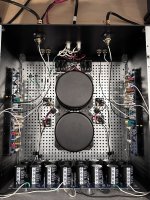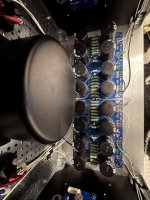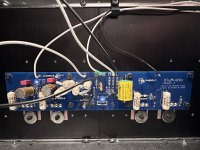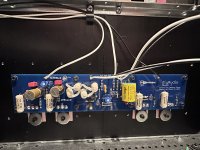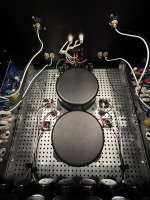Another thing to look at is the snubber circuit. There is a tool called the Cheapomodo or QuasiModo (you have to build the tool) that you can use to measure the ringing on your transformer with an oscilloscope. You use the tool to measure your transformer ringing and then adjust a trimmer pot to watch the ringing mostly go away. After you snub the ringing with the tool, you simply measure the trimmer pot and place a resistor that is close to that value into the snubber circuit. Most of the time the resistor value is 6 ohms - 20 oums. Get your amp built and take the time to understand everything first.
The snubber circuit isn't necessary but it is beneficial. So you can circle back to this later down the road but make a note of it. You will have to disconnect your transformer from the PSU board and mains to measure things. Also, assuming you are using the DIYaudio PSU board with the rectifier section, you can install the snubber circuit from the bottom.
If I buy the same transformer, could I built the snubber circuit with this recommendations, without building Quasimodo?
From https://www.diyaudio.com/community/threads/quasimodo-results-only.313202/ :
"Torroidy 500VA, 240V primary, dual 18V secondaries
Cx: 10nF
Cs: 150nF
Rs: 7Ω / 7Ω"
I agree. The Aleph's aren't known for throwing DC offset after they are built and adjusted. they are pretty stable. I don't believe Mr Pass had DC protection on any of his amps. Even the more complicated .5 and .8 series.Not trying to influence you one way or the other, but why do you feel you need a relay-based soft-start and the speaker protection for the Aleph J?
You should be good. If it is not spot on, it will likely be 95%. If you can find an 8-10 ohm resistor, that would be good so you have less risk of over snubbingIf I buy the same transformer, could I built the snubber circuit with this recommendations, without building Quasimodo?
From https://www.diyaudio.com/community/threads/quasimodo-results-only.313202/ :
"Torroidy 500VA, 240V primary, dual 18V secondaries
Cx: 10nF
Cs: 150nF
Rs: 7Ω / 7Ω"
What kind of resistance do I need? Are these suitable?
https://www.mouser.fr/ProductDetail/Vishay-BC-Components/PR03000208208JAC00?qs=6J1u%2Bx0LbWDC9FWPWBjHAQ==
https://www.mouser.fr/ProductDetail/Vishay-Dale/CPF38R2000JKB14?qs=d4jCo194jjrI1mBX%2B%2BRScQ==
https://www.mouser.fr/ProductDetail/Vishay-BC-Components/PR03000206808JAC00?qs=6J1u%2Bx0LbWD8btj5bdi8DQ==
Should I keep the 3 thermistors and this capacitor as shown here :
From : https://diyalephj.blogspot.com/2020/09/parts-rest-of-bom.html
"Second, in order to faithfully duplicate the power supply shown on the Aleph J schematic, we will need to add two terminal blocks that will attach to the chassis baseplate. These terminal blocks will be used tlo connect thermistors (to limit inrush current when the amp is turned on), as well as a capacitor for spark suppression across the AC switch and noise filtering. (If some or all of this vocabulary is over your head, have no fear, we'll explain in more detail in the power supply build post). So, to sum up, here's what we changed or added to the Universal Power Supply BOM:
Are there any other changes?
https://www.mouser.fr/ProductDetail/Vishay-BC-Components/PR03000208208JAC00?qs=6J1u%2Bx0LbWDC9FWPWBjHAQ==
https://www.mouser.fr/ProductDetail/Vishay-Dale/CPF38R2000JKB14?qs=d4jCo194jjrI1mBX%2B%2BRScQ==
https://www.mouser.fr/ProductDetail/Vishay-BC-Components/PR03000206808JAC00?qs=6J1u%2Bx0LbWD8btj5bdi8DQ==
Should I keep the 3 thermistors and this capacitor as shown here :
From : https://diyalephj.blogspot.com/2020/09/parts-rest-of-bom.html
"Second, in order to faithfully duplicate the power supply shown on the Aleph J schematic, we will need to add two terminal blocks that will attach to the chassis baseplate. These terminal blocks will be used tlo connect thermistors (to limit inrush current when the amp is turned on), as well as a capacitor for spark suppression across the AC switch and noise filtering. (If some or all of this vocabulary is over your head, have no fear, we'll explain in more detail in the power supply build post). So, to sum up, here's what we changed or added to the Universal Power Supply BOM:
- deleting D1-8, all the optional resistors, R11-12, all the snubber parts
- add two terminal blocks, three thermistors, one line capacitor (call it C9)"
Are there any other changes?
For me to continue to help, I'll ask that you please post or link the schematic you're looking at and the part reference. Otherwise, it simply takes too much time to go back and forth. Others may find it easy, and I hope you'll get more opinions, but I'm not familiar with every circuit by memory.
Example...
Would this part work for R15 in this schematic.
If you are planning to build the Aleph J per the blog you've linked, then no, you do not need the thermistors for the soft start, since you'll be using a separate circuit. You may choose to use one for the ground lift. Those terms might not mean much now, but you'll learn.
I don't want to presume anything, but based on what I've read... here is my strong recommendation.
Build the Aleph J as described in the blog you linked but adjusted for your mains voltage (if needed)
Get it up and running properly with a pair of test speakers you care nothing about
Move it to your main speakers and enjoy it for a while if everything is successful with the test speakers
The learning process of building it will make you want to accomplish more...
Decide then if you want to add speaker protection and the relay based soft-start or if it's okay without it.
You may be trying to do too much. Is this your first build?
Example...
Would this part work for R15 in this schematic.
If you are planning to build the Aleph J per the blog you've linked, then no, you do not need the thermistors for the soft start, since you'll be using a separate circuit. You may choose to use one for the ground lift. Those terms might not mean much now, but you'll learn.
I don't want to presume anything, but based on what I've read... here is my strong recommendation.
Build the Aleph J as described in the blog you linked but adjusted for your mains voltage (if needed)
Get it up and running properly with a pair of test speakers you care nothing about
Move it to your main speakers and enjoy it for a while if everything is successful with the test speakers
The learning process of building it will make you want to accomplish more...
Decide then if you want to add speaker protection and the relay based soft-start or if it's okay without it.
You may be trying to do too much. Is this your first build?
I'm sorry, I'm going too fast, I'm not detailing enough. 👍
Again thank you for your advice.
- I don't put a soft start, I put the thermistors.
- I hesitate to put the speaker protector circuit, I received the card from diyaudiostore.
- the suggested resistors above are for the snubber circuit on PSU.
- I built a PP ECL86 Dissident-Audio and a Kaneda 209 melaudia forum version (french forum). I follow the recommendations but have no electronics skills.
Again thank you for your advice.
I've been enjoying this amp for a few months now and have really been enjoying it. One thing I have been wondering about is the bottom end and why it is so soft. The bass is just isn't tight. I am trying to push Altec Lansing 604s at 16 ohms. This amp does well with these speakers, just not down low. Thinking there might be something going on with 604s, I hooked up a pair of McIntosh MC-30s. The lows are there, nice and tight.
Is there anything I can do to get nice performance down low?
Took a little time to get this, but here it is. All values in A/C mVput 1KHz sine, 1W at output, through dummy load (8R)
measure voltage AC across source resistor in lower rail, write down
measure voltage across AC resistor in upper rail, write down
inform here
goal is to find what Aleph CCS AC gain you have actually
meaning - when said is approx 50%, that means that upper half of amp OS ( exactly Aleph CCS) is having same voltage/current contribution as lower part of amp, practically amp acting as regular PP amp
if said gain is lesser than 50%, amp is leaning more to pure SE mode of operation, thus being more dependable of load value and behavior
now, having 604, efficient as bigbadaboom, you can try trick with load shunt - if you put 10-20W 16R resistor in parallel to spk, silly amp should think that 8R speaker is connected
some power to speaks, some heat to resistors, but who cares, with their efficiency
Left channel:
R16 - 11.91 mV
R17 - 11.91 mV
R18 - 18.60 mV
R19 - 18.60 mV
Right channel:
R16 - 12.0 mV
R17 - 11.90 mV
R18 - 18.60 mV
R19 - 18.70 mV
What do these numbers want to say?
when voltage across upper source resistors (Aleph CCS) are same as voltage across lower source resistors (modulated mosfets on lower rail), their current contribution is equal and we can say that "Aleph AC gain" is 50%
now, simple calculus with numbers you posted is saying that 12mV is 39% of (12+18.6)mV, so Aleph AC gain is 40%
as check, same calculus for lower half of amp, 18.6mV is ~61% of (12+18.6)mV, so all is good, speaking of calculus
and all is good speaking of Aleph AC gain of your amp - both channels are the same, and I believe it is close to Papa's figures for original Aleph J
now, you're missing bass with your amp on Altecs
care to describe what's rest of your signal chain, and what you have for preamp; feeding Aleph SE or Bal?
now, simple calculus with numbers you posted is saying that 12mV is 39% of (12+18.6)mV, so Aleph AC gain is 40%
as check, same calculus for lower half of amp, 18.6mV is ~61% of (12+18.6)mV, so all is good, speaking of calculus
and all is good speaking of Aleph AC gain of your amp - both channels are the same, and I believe it is close to Papa's figures for original Aleph J
now, you're missing bass with your amp on Altecs
care to describe what's rest of your signal chain, and what you have for preamp; feeding Aleph SE or Bal?
System is a Sota Cosmos table with a SME 4.5 arm and Ortofon 2M Black cartridge. Sutherland Insight phono preamp. Conrad Johnson PV-11 preamp. All connected with Kimber Kable Hero. Digital source is a Accuphase DP 400. Low end response doesn't change that much if I run the phono through the Sutherland or the phono stage of the the PV-11.
web sez that Rout of PV1 is les than 500R, so that's not a problem
post some pics of your Aleph inside
you can try few things with Altec connection, as test, to give us more food for thoughts:
- connect 15-20R resistor of at least 5W in parallel with Altec or amp output; that will fool Aleph with load of ~8R; inform us of result
- remove that above, connect few W resistor of 1R to 3R3 value in series with Altec; that'll fool Altec to see an amp with lesser damping factor, so bass should go looser and deeper; inform us of result
post some pics of your Aleph inside
you can try few things with Altec connection, as test, to give us more food for thoughts:
- connect 15-20R resistor of at least 5W in parallel with Altec or amp output; that will fool Aleph with load of ~8R; inform us of result
- remove that above, connect few W resistor of 1R to 3R3 value in series with Altec; that'll fool Altec to see an amp with lesser damping factor, so bass should go looser and deeper; inform us of result
FWIW, I run an Altec 414A with Altec 32C and 802D in an Altec 614 cabs driven by my Aleph J. Bass is excellent! Same result with Altec 416-B OB with LeCleach horns on top with Altec 288C (24 ohms). My brother runs a 4Pi speaker (15" JBL) with his AlephJ and the result is also the same. Have you tried CD or streaming as a source and get the same result?System is a Sota Cosmos table with a SME 4.5 arm and Ortofon 2M Black cartridge. Sutherland Insight phono preamp. Conrad Johnson PV-11 preamp. All connected with Kimber Kable Hero. Digital source is a Accuphase DP 400. Low end response doesn't change that much if I run the phono through the Sutherland or the phono stage of the the PV-11.
My lowly TD124 and Garrard 301 have excellent bass using the amp/speaker combo I mentioned above and I fear sometimes that I will develop some rumbling issues due to the low end. I do not detect lack of bass with streaming via MacMini/Bifrost DAC as well.
Hope you find the culprit.
I'm not sure if this will cure what ails you (or if I'm not seeing it correctly in the pics)...
Do you have a jumper between In- and GND?
If not, give it a try.
Lovely build, BTW. 🙂
Do you have a jumper between In- and GND?
If not, give it a try.
Lovely build, BTW. 🙂
Yes, I think that's it. Please try:
GND2 - Speaker out
GND1 - PSU GND
GND 3 - NC
IN+/IN- input + and -
IN-/ GND - jumper
GND2 - Speaker out
GND1 - PSU GND
GND 3 - NC
IN+/IN- input + and -
IN-/ GND - jumper
Last edited:
^ GND, GND1, GND2 and GND3 are on the same trace ... Why have them move other wiring. Did I miss something?
Edited - After your correction, that's what I said.
Edited - After your correction, that's what I said.
Yes, I made a typo when I first posted it and realized the mistake. Corrected!^ GND, GND1, GND2 and GND3 are on the same trace ... Why have them move other wiring. Did I miss something?
Edited - After your correction, that's what I said.
- Home
- Amplifiers
- Pass Labs
- Aleph J illustrated build guide
